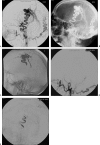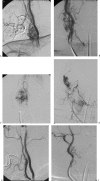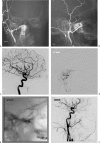Embolization in the head and neck
- PMID: 21326519
- PMCID: PMC3036447
- DOI: 10.1055/s-0028-1085929
Embolization in the head and neck
Abstract
In this article, we review current practices in therapeutic embolization of the head and neck. Major applications including vascular malformations, highly vascular tumors, trauma, and other sources of hemorrhage are discussed. We emphasize the importance of a thorough knowledge of head and neck vascular anatomy, especially of potential connections to critical territories not intended for embolization. The choice of embolic agent and its effect on safety and efficacy of treatment are presented.
Keywords: Intervention; bleeding; head and neck; tumor; vascular malformation.
Figures






References
-
- Morris P P. Practical Neuroangiography. 2nd ed. Philadelphia: Lippincott, Williams, & Wilkins; 2006.
-
- Byrne J. Interventional Neuroradiology. Oxford, UK: Oxford University Press; 2002.
-
- Osborn A. Diagnostic Angiography. 2nd ed. Philadelphia: Lippincott, Williams, & Wilkins; 1999.
-
- Bouthillier A, Loveren H van, Keller J. Segments of the internal carotid artery: a new classification. Neurosurgery. 1996;38(3):425–432. discussion 432–433. - PubMed
-
- Lapresle J, Lasjaunias P. Cranial nerve ischaemic arterial syndromes. A review. Brain. 1986;109(Pt 1):207–216. - PubMed

